Amirkoushyar Ziabari
Plug-and-Play with 2.5D Artifact Reduction Prior for Fast and Accurate Industrial Computed Tomography Reconstruction
Jun 17, 2025Abstract:Cone-beam X-ray computed tomography (XCT) is an essential imaging technique for generating 3D reconstructions of internal structures, with applications ranging from medical to industrial imaging. Producing high-quality reconstructions typically requires many X-ray measurements; this process can be slow and expensive, especially for dense materials. Recent work incorporating artifact reduction priors within a plug-and-play (PnP) reconstruction framework has shown promising results in improving image quality from sparse-view XCT scans while enhancing the generalizability of deep learning-based solutions. However, this method uses a 2D convolutional neural network (CNN) for artifact reduction, which captures only slice-independent information from the 3D reconstruction, limiting performance. In this paper, we propose a PnP reconstruction method that uses a 2.5D artifact reduction CNN as the prior. This approach leverages inter-slice information from adjacent slices, capturing richer spatial context while remaining computationally efficient. We show that this 2.5D prior not only improves the quality of reconstructions but also enables the model to directly suppress commonly occurring XCT artifacts (such as beam hardening), eliminating the need for artifact correction pre-processing. Experiments on both experimental and synthetic cone-beam XCT data demonstrate that the proposed method better preserves fine structural details, such as pore size and shape, leading to more accurate defect detection compared to 2D priors. In particular, we demonstrate strong performance on experimental XCT data using a 2.5D artifact reduction prior trained entirely on simulated scans, highlighting the proposed method's ability to generalize across domains.
Adapting Segment Anything Model (SAM) to Experimental Datasets via Fine-Tuning on GAN-based Simulation: A Case Study in Additive Manufacturing
Dec 16, 2024Abstract:Industrial X-ray computed tomography (XCT) is a powerful tool for non-destructive characterization of materials and manufactured components. XCT commonly accompanied by advanced image analysis and computer vision algorithms to extract relevant information from the images. Traditional computer vision models often struggle due to noise, resolution variability, and complex internal structures, particularly in scientific imaging applications. State-of-the-art foundational models, like the Segment Anything Model (SAM)-designed for general-purpose image segmentation-have revolutionized image segmentation across various domains, yet their application in specialized fields like materials science remains under-explored. In this work, we explore the application and limitations of SAM for industrial X-ray CT inspection of additive manufacturing components. We demonstrate that while SAM shows promise, it struggles with out-of-distribution data, multiclass segmentation, and computational efficiency during fine-tuning. To address these issues, we propose a fine-tuning strategy utilizing parameter-efficient techniques, specifically Conv-LoRa, to adapt SAM for material-specific datasets. Additionally, we leverage generative adversarial network (GAN)-generated data to enhance the training process and improve the model's segmentation performance on complex X-ray CT data. Our experimental results highlight the importance of tailored segmentation models for accurate inspection, showing that fine-tuning SAM on domain-specific scientific imaging data significantly improves performance. However, despite improvements, the model's ability to generalize across diverse datasets remains limited, highlighting the need for further research into robust, scalable solutions for domain-specific segmentation tasks.
2.5D Super-Resolution Approaches for X-ray Computed Tomography-based Inspection of Additively Manufactured Parts
Dec 05, 2024Abstract:X-ray computed tomography (XCT) is a key tool in non-destructive evaluation of additively manufactured (AM) parts, allowing for internal inspection and defect detection. Despite its widespread use, obtaining high-resolution CT scans can be extremely time consuming. This issue can be mitigated by performing scans at lower resolutions; however, reducing the resolution compromises spatial detail, limiting the accuracy of defect detection. Super-resolution algorithms offer a promising solution for overcoming resolution limitations in XCT reconstructions of AM parts, enabling more accurate detection of defects. While 2D super-resolution methods have demonstrated state-of-the-art performance on natural images, they tend to under-perform when directly applied to XCT slices. On the other hand, 3D super-resolution methods are computationally expensive, making them infeasible for large-scale applications. To address these challenges, we propose a 2.5D super-resolution approach tailored for XCT of AM parts. Our method enhances the resolution of individual slices by leveraging multi-slice information from neighboring 2D slices without the significant computational overhead of full 3D methods. Specifically, we use neighboring low-resolution slices to super-resolve the center slice, exploiting inter-slice spatial context while maintaining computational efficiency. This approach bridges the gap between 2D and 3D methods, offering a practical solution for high-throughput defect detection in AM parts.
Deep learning based workflow for accelerated industrial X-ray Computed Tomography
Sep 24, 2023



Abstract:X-ray computed tomography (XCT) is an important tool for high-resolution non-destructive characterization of additively-manufactured metal components. XCT reconstructions of metal components may have beam hardening artifacts such as cupping and streaking which makes reliable detection of flaws and defects challenging. Furthermore, traditional workflows based on using analytic reconstruction algorithms require a large number of projections for accurate characterization - leading to longer measurement times and hindering the adoption of XCT for in-line inspections. In this paper, we introduce a new workflow based on the use of two neural networks to obtain high-quality accelerated reconstructions from sparse-view XCT scans of single material metal parts. The first network, implemented using fully-connected layers, helps reduce the impact of BH in the projection data without the need of any calibration or knowledge of the component material. The second network, a convolutional neural network, maps a low-quality analytic 3D reconstruction to a high-quality reconstruction. Using experimental data, we demonstrate that our method robustly generalizes across several alloys, and for a range of sparsity levels without any need for retraining the networks thereby enabling accurate and fast industrial XCT inspections.
YOLO2U-Net: Detection-Guided 3D Instance Segmentation for Microscopy
Jul 13, 2022



Abstract:Microscopy imaging techniques are instrumental for characterization and analysis of biological structures. As these techniques typically render 3D visualization of cells by stacking 2D projections, issues such as out-of-plane excitation and low resolution in the $z$-axis may pose challenges (even for human experts) to detect individual cells in 3D volumes as these non-overlapping cells may appear as overlapping. In this work, we introduce a comprehensive method for accurate 3D instance segmentation of cells in the brain tissue. The proposed method combines the 2D YOLO detection method with a multi-view fusion algorithm to construct a 3D localization of the cells. Next, the 3D bounding boxes along with the data volume are input to a 3D U-Net network that is designed to segment the primary cell in each 3D bounding box, and in turn, to carry out instance segmentation of cells in the entire volume. The promising performance of the proposed method is shown in comparison with some current deep learning-based 3D instance segmentation methods.
Model-based Reconstruction for Enhanced X-ray CT of Tri-structural Isotropic Particles
Mar 19, 2021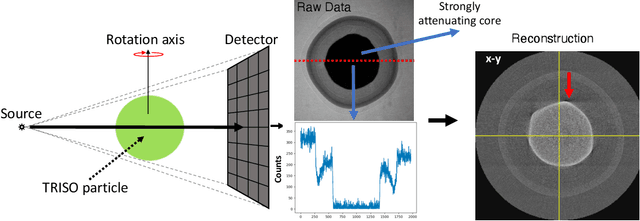
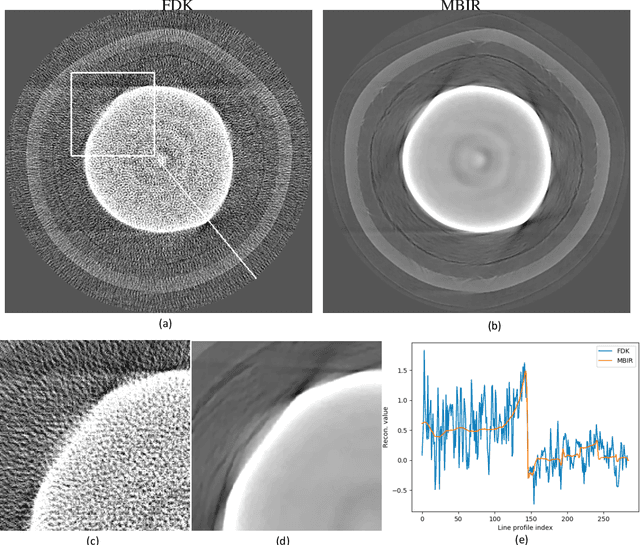
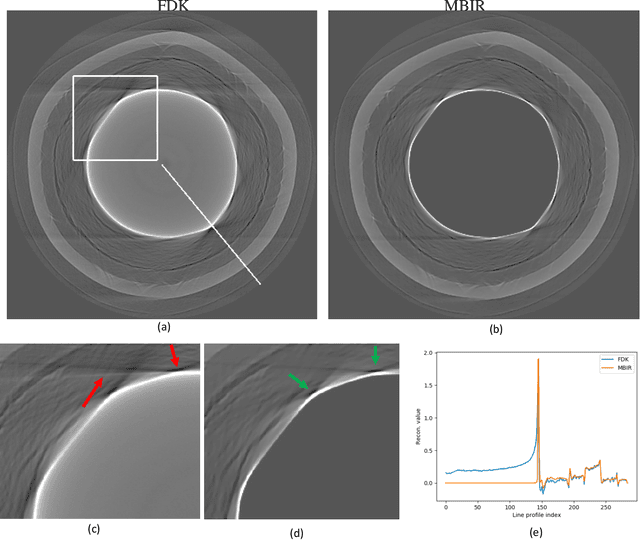
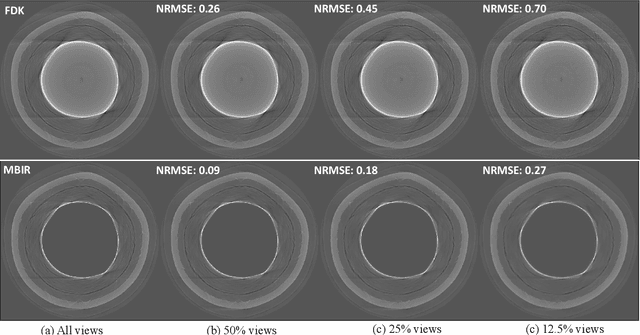
Abstract:Tri-Structural Isotropic (TRISO) fuel particles are a key component of next generation nuclear fuels. Using X-ray computed tomography (CT) to characterize TRISO particles is challenging because of the strong attenuation of the X-ray beam by the uranium core leading to severe photon starvation in a substantial fraction of the measurements. Furthermore, the overall acquisition time for a high-resolution CT scan can be very long when using conventional lab-based X-ray systems and reconstruction algorithms. Specifically, when analytic methods like the Feldkamp-Davis-Kress (FDK) algorithm is used for reconstruction, it results in severe streaks artifacts and noise in the corresponding 3D volume which make subsequent analysis of the particles challenging. In this article, we develop and apply model-based image reconstruction (MBIR) algorithms for improving the quality of CT reconstructions for TRISO particles in order to facilitate better characterization. We demonstrate that the proposed MBIR algorithms can significantly suppress artifacts with minimal pre-processing compared to the conventional approaches. Furthermore, we demonstrate the proposed MBIR approach can obtain high-quality reconstruction compared to the FDK approach even when using a fraction of the typically acquired measurements, thereby enabling dramatically faster measurement times for TRISO particles.
PABO: Pseudo Agent-Based Multi-Objective Bayesian Hyperparameter Optimization for Efficient Neural Accelerator Design
Jun 11, 2019



Abstract:The ever increasing computational cost of Deep Neural Networks (DNN) and the demand for energy efficient hardware for DNN acceleration has made accuracy and hardware cost co-optimization for DNNs tremendously important, especially for edge devices. Owing to the large parameter space and cost of evaluating each parameter in the search space, manually tuning of DNN hyperparameters is impractical. Automatic joint DNN and hardware hyperparameter optimization is indispensable for such problems. Bayesian optimization-based approaches have shown promising results for hyperparameter optimization of DNNs. However, most of these techniques have been developed without considering the underlying hardware, thereby leading to inefficient designs. Further, the few works that perform joint optimization are not generalizable and mainly focus on CMOS-based architectures. In this work, we present a novel pseudo agent-based multi-objective hyperparameter optimization (PABO) for maximizing the DNN performance while obtaining low hardware cost. Compared to the existing methods, our work poses a theoretically different approach for joint optimization of accuracy and hardware cost and focuses on memristive crossbar-based accelerators. PABO uses a supervisor agent to establish connections between the posterior Gaussian distribution models of network accuracy and hardware cost requirements. The agent reduces the mathematical complexity of the co-optimization problem by removing unnecessary computations and updates of acquisition functions, thereby achieving significant speed-ups for the optimization procedure. PABO outputs a Pareto frontier that underscores the trade-offs between designing high-accuracy and hardware efficiency. Our results demonstrate a superior performance compared to the state-of-the-art methods both in terms of accuracy and computational speed (~100x speed up).
X-Ray CT Reconstruction of Additively Manufactured Parts using 2.5D Deep Learning MBIR
May 06, 2019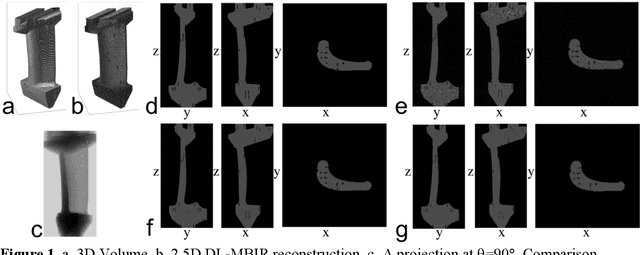
Abstract:In this paper, we present a deep learning algorithm to rapidly obtain high quality CT reconstructions for AM parts. In particular, we propose to use CAD models of the parts that are to be manufactured, introduce typical defects and simulate XCT measurements. These simulated measurements were processed using FBP (computationally simple but result in noisy images) and the MBIR technique. We then train a 2.5D deep convolutional neural network [4], deemed 2.5D Deep Learning MBIR (2.5D DL-MBIR), on these pairs of noisy and high-quality 3D volumes to learn a fast, non-linear mapping function. The 2.5D DL-MBIR reconstructs a 3D volume in a 2.5D scheme where each slice is reconstructed from multiple inputs slices of the FBP input. Given this trained system, we can take a small set of measurements on an actual part, process it using a combination of FBP followed by 2.5D DL-MBIR. Both steps can be rapidly performed using GPUs, resulting in a real-time algorithm that achieves the high-quality of MBIR as fast as standard techniques. Intuitively, since CAD models are typically available for parts to be manufactured, this provides a strong constraint "prior" which can be leveraged to improve the reconstruction.
 Add to Chrome
Add to Chrome Add to Firefox
Add to Firefox Add to Edge
Add to Edge